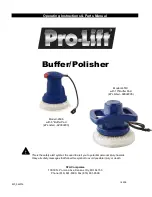
7
GB
6. The Backstop may be fixed in a raised position or almost level with the sanding belt. Ensure
that the Backstop is not in contact with the sanding belt
7. Fit dust extraction system or the Dust Bag (10)
8. Turn on the sander and use the lock-on button to keep the sander running
9. Check solidity of fixing and alignment of sanding belt whilst running the sander. If
necessary, turn off and refix the sander
WARNING:
DO NOT use the sander inverted unless it is securely clamped to the work surface.
Fitting the optional sanding frame (TBSIS)
• The sanding frame helps to control depth of cut and prevents tilting and gouging
1. Use the Inversion Clamps (15) to secure the belt sander on a solid, flat, level work surface in
an inverted position (Image I)
2. Place the Sanding Frame (18) over the sander so that, with the smooth surface of the frame
uppermost, the fixing positions on the frame correspond with the fixing positions on the
sander (Image J)
3. Insert the Frame Locking Knobs (20) on the side where there are two fixing positions then
tighten to secure the frame, but allow for a small amount of movement
4. Insert the Depth Plate Locking Knob (19) in the single fixing position (on the opposite side to
the frame locking knobs). Align the depth calibrations with the scale pointer at the position
required
Note:
For minimum sanding depth, align with calibration furthest from the frame surface
(see above)
5. Use a level to check the frame is horizontal, then tighten the Frame Locking Knobs fully to
secure the frame ready for use
Using the sanding frame
• We recommend that you begin by sanding against the grain
• Start the sander facing at 10 or 11 o’clock, and move it back and forth across the
workpiece slowly. Finish by sanding parallel to the grain
Accessories
• A full range of different grit sanding belts and accessories is available from your Triton
stockist. Spare parts can be obtained from toolsparesonline.com
Maintenance
WARNING:
Always disconnect from the power supply before carrying out any inspection,
maintenance or cleaning.
Emptying the dust bag (if fitted)
WARNING:
Always switch off and disconnect from the power supply before detaching the dust
extraction system.
1. To remove the Dust Bag (10), rotate outwards to disengage the bayonet, then pull off (Image
A)
2. Open the bag, empty and refit (see ‘Connecting the dust extraction system’)
Note:
If the sanding dust contains harmful substances, such as particles from old paint,
varnish, surface coatings etc, always dispose of according to laws and regulations.
WARNING:
For optimum dust removal, empty the Dust Bag when it is no more than half full.
Note:
Always clean the tool THOROUGHLY when switching from sanding wood to sanding
metal and vice versa.
General inspection
• Regularly check that all the fixing screws are tight. They may vibrate loose over time
• Inspect the supply cord of the tool, prior to each use, for damage or wear. Repairs should
be carried out by an authorised Triton service centre. This advice also applies to extension
cords used with this tool
Cleaning
• Keep your tool clean at all times. Dirt and dust will cause internal parts to wear quickly,
and shorten the device’s service life. Clean the body of your machine with a soft brush, or
dry cloth. If available, use clean, dry, compressed air to blow through the ventilation holes
(where applicable)
Lubrication
• Slightly lubricate all moving parts at regular intervals with a suitable spray lubricant
Changing the drive belt
Note:
A spare drive belt is supplied with the sander. Further replacements and other spare
parts are available from your Triton stockist or from toolsparesonline.com.
1. Using a Phillips screwdriver, remove the screw holding the Drive Belt Cover (5) in place
2. Remove the worn belt by easing it off the bottom larger drive pulley, and then lift away
3. Clean all dust and debris away
4. Place new drive belt over the top drive pulley and push onto the larger pulley, then rotate
the belt until it is on both pulleys and located in the grooves of each pulley
5. Place the Drive Belt Cover back on and screw the fixing screw tight
Storage
• Store this tool carefully in a secure, dry place out of the reach of children
Disposal
Always adhere to national regulations when disposing of power tools that are no longer
functional and are not viable for repair.
• Do not dispose of power tools, or other waste electrical and electronic equipment (WEEE),
with household waste
• Contact your local waste disposal authority for information on the correct way to dispose of
power tools
330125_Z1MANPRO1.indd 7
17/01/2017 17:26
Summary of Contents for 1200BS
Page 2: ...2 1 4 3 6 2 7 5 11 9 13 10 14 12 8 15 16 17 18 19 20...
Page 3: ...3 A G D E H F I B J C...
Page 8: ...8 GB...
Page 14: ...14 GB 14 NL...
Page 20: ...20 GB 20 FR...
Page 26: ...26 GB 26 DE...
Page 32: ...32 GB 32 IT...
Page 38: ...38 GB 38 ES...
Page 44: ...44 GB 44 PT...
Page 53: ...53 GB E PT E 53 RU 85 EN60745 www osha europa eu 1 a 2 a 3 a 4 a 30 5 a...
Page 62: ...62 GB E PT E PL E PT E 62 HU...
Page 68: ...68 GB E PT E PL E PT E RU E PT E PL E PT E 68 CZ...
Page 74: ...74 GB E PT E PL E PT E RU E PT E PL E PT E HU E PT E PL E PT E RU E PT E PL E PT E 74 SK...
Page 82: ......








































